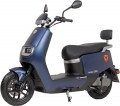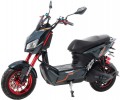Range
The range of a vehicle is the distance it can travel on a single battery charge.
Note that the range usually indicates the value for perfect operating conditions: driving at optimal speed with a small load, flat road, no ups and downs, etc. The actual range may differ from the claimed one, sometimes quite noticeably. In addition, to improve range, manufacturers can deliberately use low-power motors that consume little energy.
Max speed
The highest speed that a vehicle can reach.
When choosing according to this parameter, it is worth considering that in dense city traffic, it is rarely possible to accelerate faster than 40 km/h; so if the vehicle is bought mainly for a comfortable ride through traffic jams, then there is no need to look for a high-speed model. In addition, for the same motor power, low speed means more torque, which makes it easier to climb hills.
Max. climb angle
The maximum incline that the vehicle can overcome.
Most vehicles, even the most inexpensive ones, can cope with angles of 10 – 12 ° without problems. So you should pay special attention to this parameter only if you have to deal with very steep slopes.
It is also worth mentioning that on road signs the angle of elevation is usually indicated not in degrees, but as a percentage. This means that to evaluate the capabilities of a particular unit, it may be necessary to convert degrees to percentages or vice versa. For this, there are special tables and calculators.
Wheelbase
Wheelbase of the vehicle.
This term shows the distance between the wheels, more precisely, between the axles of the wheels. This size is one of the key parameters for any motorcycle, it determines not only the overall dimensions of the vehicle but also some of the features of the movement. So, a small wheelbase reduces the turning radius and makes the vehicle more manoeuvrable; at the same time, a longer vehicle will be more stable and predictable in corners.
More features
Additional features provided in the design of the vehicle.
—
Headlight and position lamps. Lighting devices are designed to ensure safety at night and in conditions of low visibility. Position lamps are used to highlight the vehicle on the road, the headlight can also perform this function, but its main task is to illuminate the road in front of the vehicle. In most countries, traffic rules prohibit driving on roads in the evening and at night without headlights and headlight and position lamps. Note that such lighting devices can be purchased and installed separately. However, it is easier to immediately purchase transport, where it was originally provided.
—
Turn signals. Standard turn signals are yellow or orange and are installed on both sides of the unit. Recall that according to the rules, it is necessary to indicate turns and lane changes; without light indicators, such signals have to be given by hand, removing it from the handlebar — which is not very convenient, and sometimes unsafe. Turn signals also simplify the task — to turn on the signal, just press a button or slide a switch.
—
Horn. Special sound signal. The sound signal is intended primarily to warn other road users and prevent accidents.
— Anti-theft system. Security system to prevent vehicle theft. Note that the specific way the anti-theft system works in
...different models may be different, it should be specified separately. In some cases, it is limited to notifications sent to the key fob or mobile phone that the thief is trying to move the vehicle. In other devices, the protection system can physically prevent theft — for example, by locking the steering or brakes.
— Carrier. Only containers installed in the rear of the vehicle are referred to as the carrier — a basket on the handlebar can be used in the front (see the relevant paragraph).
— Handlebar basket. A small basket is located on the handlebar of a vehicle. It is similar to the carrier (see the relevant paragraph) and is intended for the transport of various items. However, note that it is impossible to carry a lot of weight on the handlebar, this worsens stability and manoeuvrability. However, baskets usually have a small volume anyway.
— Kickstand. It is a small stand in the lower part of the body, which is laid out during parking and allows the unit to stand stably in an upright position. This function is relevant only for two-wheeled vehicles.
— Pedals. In this case, we are talking about pedals like bicycle pedals, which are placed under the driver's feet. This feature can be extremely useful in emergencies — for example, if the battery was forgotten to be charged or it discharged in the middle of the trip, if there was a malfunction in the electronics, or if it is far from charging and the battery needs to be saved. Another way to use the pedals is to assist the motor in difficult conditions, such as when driving through mud or on a steep slope.
Note that pedals are not used in minibikes — not because of difficulties of installation, but as unnecessary: in extreme cases, you can ride on such transport like on a kick scooter, pushing off the ground with your foot.Battery type
—
Lead-acid. The most popular type today. Their design is based on a combination of electrodes made of lead compounds and an electrolyte, the role of which is played by sulfuric acid diluted with water. It is the classic type of batteries that use a conventional liquid electrolyte. Their widespread use is due to their simple design and low cost, combined with good capacity and starting currents characteristic of all lead-acid batteries, as well as resistance to low temperatures (compared to other types of batteries).
—
Lithium-ion (Li-Ion). Lithium-ion technology was originally used in batteries for portable gadgets such as mobile phones, but such batteries are being used more and more recently in vehicles. Among the advantages of such batteries, one can note smaller dimensions and weight, the ability to deliver high starting currents and the ability to be charged with high currents (the latter significantly reduces the charging time), as well as numerous charge-discharge cycles. In addition, such batteries contain a minimum of harmful substances, do not use acids and heavy metals, and some models are even directly positioned as absolutely harmless to the environment. The main disadvantage of lithium-ion models is the high price.
—
Gel. A type of lead-acid battery in which the electrolyte is not liquid, but condensed to a gel state. This design prov
...ides several advantages compared to the classic version (see above): more charge-discharge cycles (which means longer service life); minimum leakage of electrolyte and associated gases; no need for maintenance; resistance to deep discharges and temperature fluctuations, etc. On the other hand, such batteries cost significantly more.Battery capacity
The capacity of the battery installed in the vehicle, in ampere-hours.
Theoretically, the battery life of the vehicle directly depends on this parameter: a more capacious battery can supply the electric motor longer. However, the actual amount of stored energy depends not only on the capacity in amp-hours but also on the nominal voltage of the battery. A more correct unit in this sense is watt-hours, taking into account the difference in nominal voltages; see "Battery capacity" below for details on this designation. Additionally, the operating time on a charge will depend not only on the characteristics of the battery but also on the power consumption of the vehicle itself — and it is determined by the motor power and several other parameters.
Weight
The total weight of the vehicle without cargo and rider.
The
lighter the unit, the greater the range and, accordingly, the weight of the payload that can be carried on it. On the other hand, too little weight adversely affects the stability, and sometimes the overall strength of the structure.

